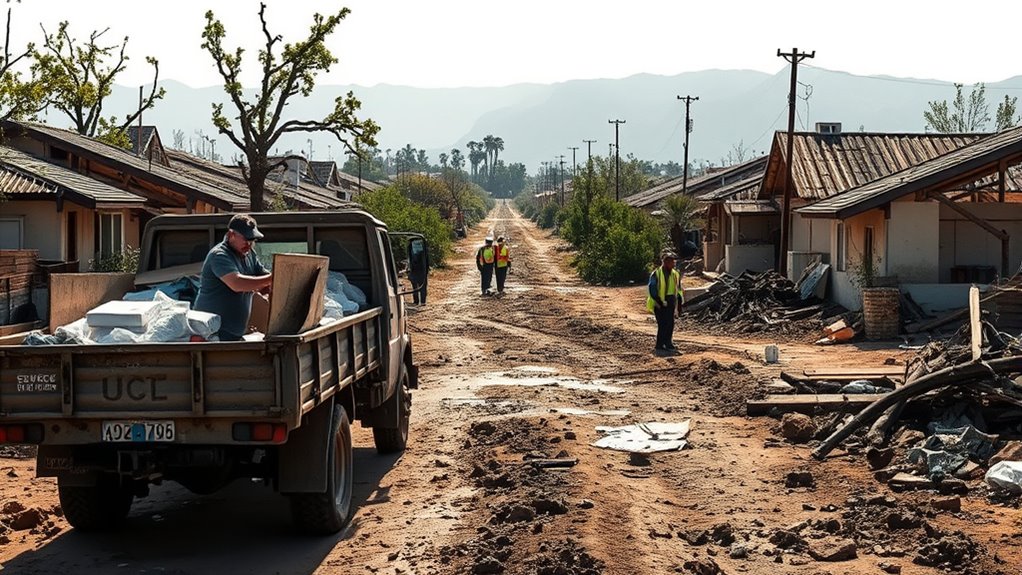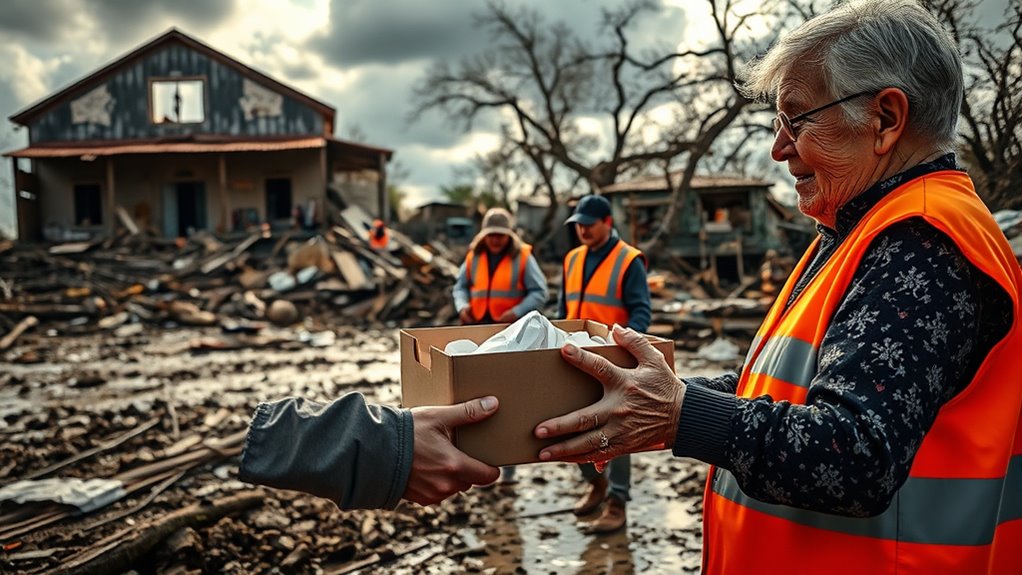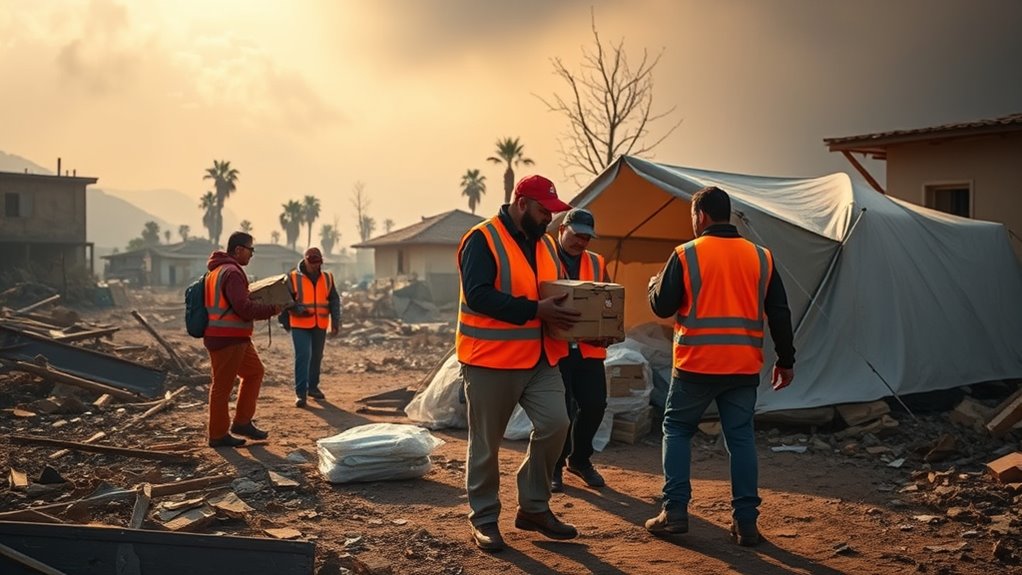You might not realize that you can claim unreimbursed disaster-related losses using IRS Form 4684, which can lower your taxable income, or that certain disaster relief payments are nontaxable if they cover specific expenses like housing, medical, or repair costs. Additionally, you can withdraw money from your retirement plan without penalties to aid recovery, and some states offer extended deadlines for filing. Stay alert—discovering these lesser-known tax benefits could substantially ease your recovery efforts.
Key Takeaways
- Unreimbursed disaster-related losses can be deducted using IRS Form 4684, potentially reducing taxable income.
- Extensions are available for filing and paying taxes in federally declared disaster areas, sometimes retroactively.
- Supporting documentation like photos, receipts, and official declarations are essential for claiming disaster-related deductions.
- Certain disaster relief payments for property damage, housing, or medical expenses are nontaxable if not reimbursed.
- You can choose to deduct casualty losses in prior years by filing amended returns, maximizing tax benefits from disaster events.
Federal Tax Deadline Extensions for Disasters in 2025

In 2025, the IRS grants federal tax deadline extensions for taxpayers affected by federally declared disasters, giving you extra time to file and pay. This relief helps you manage your disaster insurance claims and strengthens your emergency preparedness. If you’re in a designated disaster area, your deadlines for filing returns and paying taxes are extended—sometimes retroactively—covering individuals, businesses, and specific payments like quarterly estimated taxes. For example, Texas’ severe storms from July 2, 2025, extend deadlines until February 2, 2026, while Florida’s hurricane relief pushes deadlines to May 1, 2025. These extensions help you avoid penalties, giving you the breathing room to focus on recovery efforts without stressing over immediate tax obligations. Always check if your area qualifies to maximize this essential disaster relief by verifying the specific disaster area through IRS announcements. Additionally, understanding disaster relief regulations can help you better navigate the complexities of tax extensions and recovery processes.
How to Claim Unreimbursed Disaster-Related Losses

Wondering how to claim unreimbursed disaster-related losses on your taxes? Start by identifying your casualty losses, which include damage from federally declared disasters. Use IRS Form 4684 to report these losses, detailing the amount and nature. Remember, only unreimbursed losses qualify; reimbursements reduce your deduction. If you’re dealing with a qualified disaster, you can choose to deduct losses in the current or prior year—this election can accelerate your tax relief. Calculate your deductible loss as the lesser of your property’s adjusted basis or the decline in fair market value, subtracting allowances like a $500 reduction per event. Keep thorough documentation—photos, receipts, insurance claims—to support your claim. Additionally, understanding disaster relief programs can provide further financial assistance beyond deductions. These deduction strategies can help maximize your relief when recovering from disaster damages. Wildfire damages are considered natural disasters and are eligible for casualty loss deductions under IRS rules.
Nontaxable Disaster Relief Payments and What They Cover

After figuring out how to claim unreimbursed disaster-related losses on your taxes, it’s important to understand which disaster relief payments are nontaxable. Generally, payments covering specific expenses are excluded from income if not reimbursed by insurance. These include:
- Housing assistance: Temporary rent payments during recovery.
- Medical and dental costs: Unreimbursed expenses caused by the disaster.
- Funeral expenses: Costs related to disaster fatalities.
- Repair and rebuilding costs: Expenses for restoring your damaged home.
Payments for property damage up to your adjusted basis are *not* included in gross income, but amounts exceeding this basis could lead to *taxable gains*. Remember, insurance reimbursements reduce the nontaxable amount, preventing double benefits.
Using Disaster-Related Distributions From Retirement Plans

How can you effectively use disaster-related distributions from your retirement plans? These distributions provide a crucial tool during disaster recovery, allowing you to access up to $22,000 from all plans and IRAs within 180 days of the incident. They’re exempt from the 10% early withdrawal penalty, helping you manage financial setbacks without extra tax burdens. The income can be spread over three years or recognized fully in one year using IRS Form 8915-F, giving you flexibility in your retirement planning. You can also repay all or part of the distribution within three years, treating it as a rollover. For home purchases related to the disaster, distributions can be repaid to avoid taxes. Using these provisions wisely can ease your recovery process and protect your retirement savings during difficult times. Understanding the impact of physical symptoms in pregnancy can help you better navigate your recovery and financial planning.
State-Specific Disaster Relief Deadlines and Extensions

State-specific disaster relief deadlines vary depending on where you live, so it’s crucial to stay informed about local extensions. Some states, like Alabama and North Carolina, have automatic extensions for all taxpayers, while others, such as Texas and Virginia, have relief limited to certain counties. Knowing how local impacts influence filing deadlines can help you avoid penalties and ensure timely compliance. Being aware of regulatory changes can help taxpayers plan accordingly and take advantage of available extensions.
State Deadlines Variations
Did you know that disaster relief deadlines can vary considerably from state to state? Depending on where you live, your filing date might be extended differently. Here are some key variations:
- Some states, like Alabama, Florida, Georgia, North Carolina, South Carolina, and Virginia, automatically extend deadlines to May 1, 2025, for the 2024 tax year.
- Certain counties in Alaska, New Mexico, Tennessee, and Virginia qualify for specific relief.
- State-specific relief may include extensions for insurance claims and volunteer assistance programs.
- Deadlines can start as early as September 22, 2024, and last until May 1, 2025, depending on the disaster impact area.
- Being aware of disaster relief guidelines helps ensure timely filing and access to benefits.
Local Disaster Impact
Understanding how local disaster impacts influence tax relief is vital for planning your filings and payments. When communities face severe storms, flooding, or other disasters, the IRS grants extensions to support volunteer assistance and community recovery efforts. For example, specific counties in Virginia and Texas have extended deadlines to help residents and businesses rebuild. These extensions allow you to delay filing income, estate, or employment taxes until May 1, 2025, in many affected areas. This relief not only eases the financial burden but also encourages local volunteer efforts and community recovery by providing additional time to manage casualty losses and apply for disaster-related deductions. Certain areas also qualify for additional relief options, further aiding community rebuilding efforts. Staying aware of these disaster relief measures ensures you maximize available tax benefits and support your community’s recovery.
Documenting Your Disaster Expenses for Tax Purposes

To guarantee your disaster-related expenses qualify for deductions, you need to keep detailed records of everything. Save all receipts and invoices for repairs, supplies, and services, and track your expenses carefully. Proper documentation makes it easier to substantiate your claims and avoid issues with the IRS. Supporting documentation is essential to ensure your claims are accepted and to maximize your deduction potential. Additionally, understanding sound healing science can help you incorporate stress-reducing activities into your recovery process.
Keep Detailed Records
Keeping detailed records is essential for substantiating your disaster-related expenses on your taxes. Proper documentation proves property ownership and liability, key for IRS approval. To guarantee your claim is solid, focus on:
- Legal documents like deeds or leases that confirm property ownership or contractual liability proof.
- Timely records showing the exact date and type of disaster, including official declarations and immediate photos or videos.
- Damage causation evidence, such as contractor estimates or before-and-after visuals, linking damage directly to the disaster.
- Reimbursement documentation—records of claims filed, correspondence, and whether losses are unreimbursed.
- Supporting documentation should also include any appraisals or expert opinions that establish the property’s decline in value due to the casualty. Understanding casualty losses staying organized prevents delays or denials and provides irrefutable proof during IRS review. Accurate records of property ownership, liability, and timing are your strongest defense.
Save Receipts and Invoices
Saving receipts and invoices is vital for accurately documenting your disaster-related expenses on your taxes. These records help demonstrate the true amount spent on repairs, replacement materials, and services, especially when calculating casualty loss deductions and property valuation. Keep receipts that show ownership or contractual liability, as they validate your claims. They also serve as evidence of expenses exceeding insurance claims, which is essential for determining your net deductible loss. Original purchase records support establishing your property’s adjusted basis, directly impacting your loss calculations. Organizing these documents—by category and date—makes tax filing straightforward and strengthens your case if audited. Proper documentation ensures you maximize deductions while complying with IRS requirements, ultimately helping you recover more financially from the disaster. Using detailed self watering plant pots records can simplify the process of tracking your property-related expenses over time.
Track Disaster-Related Expenses
Track Disaster-Related Expenses (Documenting Your Disaster Expenses for Tax Purposes)
Accurately tracking disaster-related expenses is essential for maximizing your tax benefits after a disaster. To do this effectively, you should:
- Keep detailed records of all costs, including emergency repairs, temporary housing, and replacements.
- Document insurance claims filed and any reimbursements received, noting casualty thresholds like the $100 per casualty and 10% of adjusted gross income limits.
- Use receipts, repair estimates, photographs, and bank records to prove damage and expenses.
- Record the type of disaster, date of occurrence, and whether a loss was directly caused by the event.
- Verify disaster area eligibility to ensure your expenses qualify for deduction or relief programs.
- Be aware of casualty loss thresholds that determine whether your loss qualifies for deduction, which helps in accurate reporting.
Maintaining thorough documentation guarantees you can substantiate your deductions, especially when calculating qualified disaster losses on IRS Form 4684 and verifying the casualty thresholds.
Leveraging Disaster Losses to Offset Income in Previous Years

Have you experienced a federally declared disaster and wondered if you can get tax relief sooner? You can, by electing to deduct your disaster-related casualty losses in the prior year. This allows you to offset previous income, potentially leading to a bigger refund or lower tax bill now. To do this, you’ll need to file an amended return or claim the loss on your original return before the deadline. Keep in mind, your loss must be unreimbursed and result from a sudden, unexpected event like a flood or fire, with disaster insurance or community aid helping cover some costs. Proper documentation, including insurance claims and photos, is essential. Documentation requirements are crucial for supporting your claim. This strategy helps you leverage disaster losses and accelerate tax benefits, especially if the previous year’s income was higher. Recent regulations clarify the procedures and deadlines for making these elections, making it easier to take advantage of this tax relief option.
Understanding the IRS’s Guidance on Disaster Tax Relief

Understanding the IRS’s guidance on disaster tax relief helps you navigate claiming casualty losses, including rules for when and how to file. You’ll also want to know which relief payments are nontaxable and how they impact your income. Additionally, the IRS provides specific rules for disaster-related retirement distributions to maximize your benefits.
Disaster Loss Claim Rules
When claiming disaster-related casualty losses, you need to follow specific IRS rules that determine when and how to file your deductions. To guarantee your claim is valid, consider these key points:
- You can choose to claim losses on your current year or previous year’s return.
- Extended deadlines may apply, especially for federally declared disasters, giving you more time.
- Always include the FEMA disaster number to verify your eligibility.
- If you received insurance reimbursements, subtract these amounts from your loss to avoid double-dipping.
Nontaxable Relief Payments
After maneuvering the rules for claiming disaster-related casualty losses, it’s important to recognize that certain relief payments are considered nontaxable under IRS guidelines. These payments, often provided through volunteer opportunities or disaster preparedness efforts, include grants and payments for essential living expenses from government or qualified nonprofit organizations. They cover needs like food, shelter, clothing, medical treatment, and clean-up costs, as long as they’re used for immediate disaster-related needs within a federally declared disaster area. To qualify, you need proper documentation, such as FEMA confirmation, and must show funds were used for disaster expenses. Remember, these payments don’t affect your eligibility for other tax relief, helping you recover without unexpected tax consequences.
Retirement Distribution Benefits
Are you eligible for disaster-related retirement distribution benefits? If your principal residence is in a federally declared disaster area and you’ve experienced economic loss, you may qualify for special relief through retirement plan withdrawals. Here’s what you should know:
- You can withdraw up to $22,000 from your IRA or eligible plan without facing the usual 10% early distribution penalty.
- The distribution must relate to the disaster, with documentation of your loss possibly required.
- You can spread the taxable income over three years or repay the amount within that time, easing your disaster relief strategies.
- The tax treatment allows waiving penalties, with the option to treat the withdrawal as a rollover if repaid.
These benefits make managing retirement plan withdrawals easier during disaster recovery, but ensure you stay updated on IRS guidance.
Eligible Expenses for Nontaxable Disaster Relief Funds

What expenses qualify for nontaxable disaster relief funds? Qualified costs include personal, family, living, or funeral expenses, as well as property restoration. These funds help bolster disaster preparedness and community resilience. Eligible expenses also cover temporary housing, medical supplies, food, and utilities, ensuring you can recover without tax implications. To clarify, here’s a quick overview:
| Expense Type | Description |
|---|---|
| Housing Assistance | Temporary housing costs |
| Property Damage Repairs | Restoring or replacing damaged property |
| Medical & Food Supplies | Disaster-related medical and food aid |
| Funeral Expenses | Funeral costs related to disasters |
These expenses support swift recovery and community resilience, without adding tax burdens. Additionally, disaster relief funds are generally considered tax-free if used for qualified expenses, providing further financial support during recovery.
Staying Updated on Future Disaster Relief Measures

Staying informed about future disaster relief measures is essential to guarantee you can access the latest support and navigate changing policies effectively. To strengthen your disaster preparedness and enhance community resilience, keep an eye on key updates:
- Legislative changes like the FEMA Act of 2025, which aim to improve disaster response and streamline relief efforts.
- IRS updates on tax relief deadlines, ensuring you meet new requirements and avoid penalties.
- New risk reduction policies advocating early integration into planning and infrastructure projects.
- Emerging resilience standards and fiscal incentives designed to promote resilient investments and reduce future damages.
Frequently Asked Questions
Can I Still Claim Disaster Losses if I Missed the Deadline?
If you missed the disaster claim deadlines, you might still be able to claim the loss if an extension was granted. Extensions help protect your tax deduction eligibility by postponing filing deadlines. Without an extension, you generally can’t claim the loss for that year. However, if you’re eligible, you can choose to deduct the disaster loss on a prior year’s return by filing an amended return with Form 4684.
Are There Limits on How Much I Can Withdraw From Retirement Plans?
You might think there’s no limit to how much you can withdraw from your retirement plan, but plan distribution rules set clear boundaries. In 2025, you can contribute up to $23,500 or $34,750 with catch-up, but withdrawals before 59 ½ usually face penalties. So, while it feels like your money is limitless, federal limits and rules govern your access, reminding you that even retirement savings have their boundaries.
Do I Need IRS Approval to Classify Relief Payments as Nontaxable?
You don’t need IRS approval to classify relief payments as nontaxable, but you must follow IRS guidelines for relief classification. The IRS relies on IRS Publication 3833, which details the criteria for payments to qualify as disaster relief and be excluded from income. verify the payments are for qualified expenses and meet the charitable or governmental purpose, as misclassification could lead to taxable income or penalties.
How Do I Document Disaster-Related Expenses for Tax Deductions?
To document disaster-related expenses for tax deductions, keep all receipts required for repairs and damages. Use clear documentation tips like taking photos and videos of the damage, maintaining repair records, and tracking insurance reimbursements. Record pre- and post-disaster fair market values, and keep original purchase documents. Proper documentation guarantees IRS compliance and helps substantiate your claims if questioned, making your deduction process smoother and more accurate.
Will the IRS Notify Me of Future Disaster Relief Updates Automatically?
Think of disaster relief notifications as your personal weather forecast—sometimes it’s automatic, and sometimes you need to check for updates. The IRS provides automatic updates for disaster relief, but you won’t get direct notices unless your address is in the affected area. To stay informed, regularly visit the IRS website or subscribe to their news services, ensuring you’re always in the know about upcoming disaster relief updates.
Conclusion
By staying informed about these lesser-known disaster relief deductions, you can maximize your benefits and ease financial stress. Remember, the idea that “what you don’t know can’t hurt you” isn’t always true—sometimes, ignorance costs you money. Keep up with IRS guidance and deadlines, and you might find that understanding these hidden options makes all the difference during tough times. Knowledge truly is your most valuable tool for disaster recovery.









